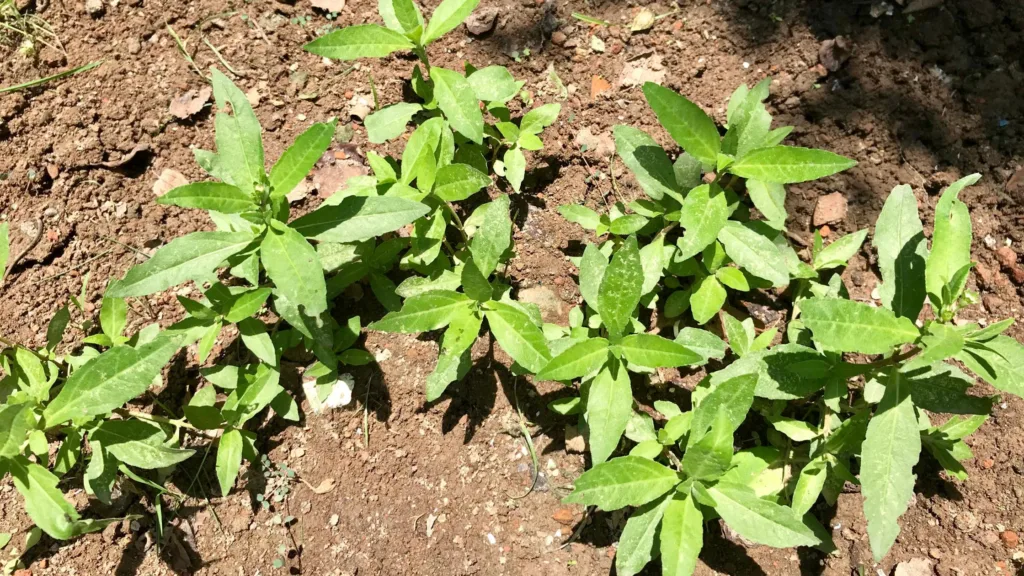Yellow Bhringraj Plant
The yellow bhringraj plant, with its scientific name Eclipta alba, is a tiny but powerful herb native to India. It flourishes in the tropics and is easily recognizable by its cheerful yellow, daisy-like flowers. This flowering member of the Asteraceae family boasts a long history in Ayurvedic medicine, where its name, translating to “hair of the king” in Sanskrit, reflects its traditional use as a hair tonic. Standing tall with erect or spreading stems reaching up to 60 cm, this small and hairy annual herb is often found near water bodies or in wastelands, preferring moist and shady areas. While its vibrant flowers might be a delightful addition to any environment, the true significance of yellow bhringraj lies in its potential health benefits.

How to Identify Bhringraj Plant
The Bhringraj plant, also known as Eclipta prostrata, is a medicinal herb with a rich history in traditional Ayurvedic medicine. Here are some key features to help you identify it:
- Leaves:
- Bhringraj leaves are simple, opposite, and elongated.
- They have a dark green color and are lance-shaped or spatulate.
- The leaf margins may be slightly toothed or entire (smooth).
- The leaves grow directly from the stem without petioles (leaf stalks).
- Stem and Growth Habit:
- Bhringraj has a prostrate or creeping growth habit.
- The stems are slender, hairy, and often reddish-brown.
- Flowers:
- Bhringraj produces small, white or yellow flowers with five petals.
- The blooms cluster at the terminals of the stalks.
- Fruit:
- After flowering, Bhringraj develops small, rounded or oblong fruits containing seeds.
- Medicinal Properties:
- Bhringraj is renowned for its hair benefits. It is used in hair oils, tonics, and shampoos to promote hair growth, prevent premature graying, and reduce hair fall.
- It also has hepatoprotective properties, supporting liver health.

Bhringraj Plant Seeds
Bhringraj plant seeds are available for purchase from various online retailers and some garden centers. Bhringraj, also known as Eclipta alba, is a flowering herb in the Asteraceae family, native to the Indian subcontinent but naturalized in many tropical regions. These tiny seeds hold the potential to grow a plant valued in Ayurvedic medicine for its hair and overall health benefits.
Bhringraj Plant Benefits
The Bhringraj plant offers several health benefits, particularly in traditional Ayurvedic medicine. Here are some notable advantages:
- Hair Health:
- Bhringraj is renowned for its positive impact on hair. It is commonly used in hair oils, tonics, and shampoos.
- Benefits include promoting hair growth, preventing premature graying, and reducing hair fall.
- Liver Support:
- Bhringraj has hepatoprotective properties, which means it supports liver health.
- It may help protect the liver from damage and improve its overall function.
- General Wellness:
- Some traditional uses of Bhringraj include treating skin conditions, improving digestion, and boosting immunity.
Bhringraj Plant Care
The bhringraj plant, with its sunshine-yellow flowers and reputation for promoting healthy hair, is a welcome addition to any home. But to thrive, this little powerhouse needs some TLC. Here’s a breakdown of bhringraj plant care to keep it flourishing:
Light: Bhringraj enjoys a balance. While it can tolerate some direct sun, especially in the cooler mornings, too much harsh afternoon sun can scorch the leaves. Aim for a location with dappled sunlight or filtered light for most of the day. An east-facing window is ideal.
Water: Consistent moisture is key, but avoid overwatering. When the top inch of soil seems dry to the touch, water it thoroughly. During warmer weather, you may need to water everyday. Make sure the pot has drainage holes to avoid waterlogging, which may cause root rot.
Soil: Bhringraj prefers well-draining, fertile soil. A good potting mix for herbs or a mixture of potting soil, perlite, and compost will work well.
Temperature and Humidity: Bhringraj thrives in warm temperatures, ideally between 10-35°C (50-95°F). It tolerates average humidity levels found in most homes.
Fertilizer: While not strictly necessary, a light feeding with a balanced organic fertilizer once a month during the growing season can give your bhringraj a boost.
Pruning: Regular light pruning encourages bushier growth and promotes new flower production. Pinch off spent flowers and any leggy stems to maintain a compact shape.
Harvesting: You can harvest bhringraj leaves throughout the growing season. Simply snip off what you need, and the plant will continue to produce new growth.
Pests and Diseases: Bhringraj is generally resistant to pests and diseases. However, keep an eye out for common houseplant issues like mealybugs or aphids. Neem oil spray can be a natural solution for these problems.
By following these simple steps, you can create a thriving bhringraj plant that will reward you with its vibrant beauty and potential health benefits.



I precisely needed to say thanks again. I do not know the things that I would’ve gone through in the absence of the entire creative ideas documented by you directly on that field. It was a real depressing issue in my position, however , noticing your expert manner you managed that took me to jump with delight. I’m happier for the assistance and in addition have high hopes you find out what a great job your are carrying out instructing many people using a web site. I know that you have never come across all of us.